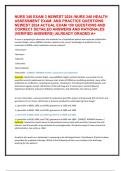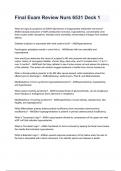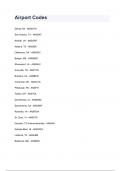NURS 340 EXAM 3 NEWEST 2024 /NURS 340 HEALTH
ASSESSMENT EXAM AND PRACTICE QUESTIONS
NEWEST 2024 ACTUAL EXAM 150 QUESTIONS AND
CORRECT DETAILED ANSWERS AND RATIONALES
(VERIFIED ANSWERS) |ALREADY GRADED A+
A nurse is preparing to administer the antibiotic for a hospitalized patient who acquired a Methicillin-
resistant Staph. aureus (MRSA) infection. Based on the nurses' knowledge of antibiotics for the
treatment of MRSA, which medication may be ordered?
Vancomycin
Neomycin
Cefazolin
Ceftaroline
Metronidazole
Piperacillin - CORRECT ANSWER-Answer: Vancomycin and ceftaroline
Rationale: Methicillin-resistant Staph. aureus(MRSA), highly resistant bacteria, are resistant to all
penicillins and all cephalosporins. Because most strains of MRSA are multidrug resistant, many other
antibiotics are ineffective, including tetracyclines, clindamycin, trimethoprim/sulfamethoxazole, and
beta-lactam agents (except ceftaroline). Preferred drugs are IV vancomycin, linezolid [Zyvox],
daptomycin [Cubicin], telavancin [Vibativ], clindamycin, and ceftaroline. See Lehne p. 1017
A nurse transcribes a new prescription for potassium penicillin G given intravenously (IV) q 8 hours and
gentamicin IV q 12 hours. Which plan is the best schedule for administering these drugs?
a.) penicillin at 0800, 1600, and 2400; gentamicin at 1200 and 2400
b.) penicillin at 0600, 1400, and 2200; gentamicin at 0600 and 1800
c.) penicillin at 0800, 1600, and 2400; gentamicin at 0600 and 1800
d.) penicillin at 0100, 0900, and 1700; gentamicin at 0900 and 1800 - CORRECT ANSWER-Answer: C
Rationale: Gentamicin should never be administered concurrently with penicillin, because they will
interact, and the penicillin may inactivate the aminoglycoside. All options except A show concurrent
administration. See Lehne p. 1064
A patient who works as a landscaper is preparing to be discharged home. Ciprofloxacin (Cipro) has been
prescribed for outpatient therapy. Which of the following will the nurse include in the discharge
teaching for this patient?
,"You may take the medication with milk of magnesia."
"Use sunscreen and protective clothing when outdoors."
"Take the medication with crackers and cheese."
"Take the medication until all symptoms subside." - CORRECT ANSWER-"Use sunscreen and protective
clothing when outdoors."
Rationale: The patient, a landscaper, should be advised to wear sunscreen and protective clothing when
outdoors, because the medication may cause phototoxicity. The medication should be taken until it is
gone, not just until the patient's symptoms are improved. Absorption of fluoroquinolones is reduced
when taken with a number of products including aluminum or magnesium containing antacids and milk
or other dairy products. See Lehne p. 1087
A hospitalized patient is receiving gentamicin (Garamycin) 80 mg IV twice daily for acute osteomyelitis.
Which data about the patient is most important for the nurse to obtain before administering the
gentamicin?
a.) oral temperature
b.) reports of nausea
c.) BUN and creatinine levels
d.) when an antacid was administered - CORRECT ANSWER-Answer: C
Rationale: Although the patient's temperature will be monitored on a regular basis in the hospital,
gentamicin is nephrotoxic and can cause renal failure. Therefore monitoring renal function is critical.
Nausea is not a common side effect of IV gentamicin. Because the drug is administered IV, an antacid
will not affect absorption of the gentamicin.
A patient has acquired hospital-associated MRSA. Which drug does the nurse anticipate will be ordered
to treat this infection?
vancomycin (Vancocin)
TMP/SMZ (Bactrim)
imipenem (Primaxin)
azithromycin (Zithromax) - CORRECT ANSWER-Answer: Vancomycin
Rationale: MRSA is resistant to all penicillins and cephalosporins. These include beta lactam antibiotics
such as imipenem. Most strains of MRSA are also resistant to many other antibiotics. The drug of choice
is vancomycin although there are others that may be used. TMP/SMZ is a preferred drug for community-
,acquired MRSA. Azithromycin is a macrolide used for respiratory and skin infections as well as other
infections such as mycobacterium avium and chlamydia.
A patient who is receiving penicillin begins to wheeze and reports a feeling of impending doom. Upon
assessing the patient, the nurse finds a blood pressure of 88/47 mm Hg. and a weak pulse of 120 beats
per minute. Which order will the nurse implement first?
A.) administer 500 mL IV fluid bolus
B.) apply oxygen at 3L per nasal cannula
C.) administer epinephrine
D.) obtain an oropharyngeal airway device - CORRECT ANSWER-Answer: C
Rationale: The priority is to reverse the allergic reaction. This can be done by administering epinephrine,
which is used to treat anaphylaxis (which the patient is manifesting). If the reaction is not reversed, an
airway may be necessary. Oxygen is applied after the epinephrine is administered or a second nurse may
apply the oxygen as the epinephrine is being given. IV fluids may be a consideration if the blood
pressure does not rise after administration of epinephrine, but epinephrine is the priority. See Lehne, p.
1020
The nurse is reviewing laboratory test results for a patient who is starting penicillin G. Which test result,
if elevated, would suggest a contraindication to penicillin G?
hematocrit and hemoglobin
BUN and creatinine
liver enzymes SGOT and ALT
PT/INR - CORRECT ANSWER-BUN and creatinine
Rationale: Treatment with penicillin drugs requires normal kidney function. The BUN and creatinine level
are indicators of kidney function. PT/INR is indicted for warfarin, not pencillin. Penicillin does not affect
red cell production or cause bleeding so hematocrit and hemoglobin are not needed. SGOT and ALT are
indicated for drugs that are hepatotoxic, which penicillin is not. See Lehne, p. 1062
Which of the following would be classified as a suprainfection?
A.) peritonitis that developed after surgery for a ruptured appendix
B.) monilial vaginal infection that developed during antibiotic therapy
C.) pneumonia in a patient with chronic obstructive pulmonary disease
D.) varicella outbreak after injection with varicella vaccine - CORRECT ANSWER-Answer: B
, Rationale: "A suprainfection is defined as a new infection that appears during the course of treatment
for a primary infection." Normal flora are inhibited by the antibiotic which then allows a secondary
infectious agent to thrive.
An hour after an amphotericin B infusion was started, the patient experiences a sudden episode of
fever, chills, rigors, and nausea. Which drug, ordered as needed for this patient, should the nurse
administer at this time?
diphenhydramine (Benadryl)
acetaminophen (Tylenol)
dantrolene (Dantrium)
hydrocortisone - CORRECT ANSWER-Dantrolene
Rationale: Fever, chills, rigors, and nausea are symptoms of an infusion reaction. This type of reaction
occurs 1 to 3 hours after the infusion is started and can last for an hour. Intravenous dantrolene or
meperidine is given for rigors. Pre-treatment with acetaminophen and diphenhydramine may reduce
the occurrence of mild reactions. Glucocorticoids are used if other measures are ineffective, but reduce
the patient's ability to fight the infection. See Lehne pg 1138.
The nurse is reviewing a patient's test results before administering the next dose of amphotericin B. The
nurse's priority is to review which one of the following tests?
A.) blood cultures
B.) serum sodium levels
C.) liver function tests
D.) serum creatinine levels - CORRECT ANSWER-Answer: D
Rationale: Amphotericin B is highly nephrotoxic and some degree of renal impairment occurs in almost
all patients who receive this drug. Therefore, it is of vital importance to closely monitor renal function in
patients who are receiving amphotericin B. The dosage of the drug may need to be reduced. Blood
cultures, if ordered, would have been drawn before the initial dose. Potassium levels, not sodium levels,
should be monitored secondary to renal damage. Liver failure is a rare adverse effect. See Lehne pg
1094.
A patient complains of mouth sores during antibiotic therapy. Upon assessment, the nurse notes white,
patchy spots and redness of the tongue and throat. Which of the following medications could be used to
treat this condition? (Select all that apply.)
A.) clotrimazole troche






